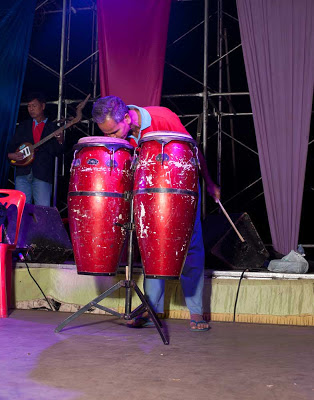 |
| Khene Player Performing During Morlam Lao Show |
Last week we attended one of my brother-in-law's Morlam Lao shows in the village of Si That here in Isaan. The show was part of a festival at a Wat in the area. The festival was raising funds for the local Wat. Although the show was free, the performance attracted people to the Wat grounds where they could purchase handicrafts, food, drinks, play carnival type games such as "Pop the Balloons with darts", or just plain out make a donation to the Wat while they were there. The key was to get the people through the gates. A Morlam Lao show here in Isaan is always good to attract a crowd.
I have lived in Thailand for five years now and I don't know how many of these shows that I have attended other than it has been quite a few. These shows are performed for all kinds of reasons such as weddings, house warming, Monk ordination celebrations, anniversary of deaths, running for political office, giving thanks for winning an election, local festivals, certain holidays, fundraisers for Wats, and I guess for no other reason than they are fun.
I am fortunate that my brother-in-law earns his living as an entertainer. I am made aware of many of these shows. Most of these shows are small village events without any advertising other than word of mouth. With his involvement in may of the shows and with Duang's large extended family, there seems to be ample mouths to get the word to me. I enjoy these shows very much - the music, the pretty girls who perform, and interacting with the people. I also enjoy getting out with the local people and dancing "fawn Lao" style.
 |
| Dancer Applying Make-up Backstage |
 |
| A Dancer Ready To Go Up On Stage |
"Same same, but different" can be an aggravating phrase to many, but for me it captures some of the allure of living here in Isaan. Thai food is renown for the varied textures and flavors of each individual dish. The simplest of dishes is actual quite sophisticated for the palate. Well life is also quite remarkable when you allow yourself to fully explore it and delve deeper beneath its surface. "Same same, but different" exemplifies the possibilities for us. What may seem banal and common place, can be stimulating and rewarding if we just allow ourselves to recognize and appreciate its subtleties.
 |
| Khene Player In Si That |
Once the khene player had changed into his "work clothes" and completed his make-up he looked completely different than the person who sat behind me in the truck.
Once he grabbed his khene and went up on stage he was a different person than the person who sat behind me in the pick up truck. He had been completely transformed.
So what is the khene and what significance does it have to Morlam Lao music? The khene is a reed instrument. It is the ubiquitous instrument of Lao music and in many aspects it helps to define Lao culture. The khene is to Lao music what the lead electrical guitar is to rock and roll music. Besides playing the melody, the khene player, like the lead guitarists, also creates the environment in which the singer performs. The khene player dances, struts, and jumps about the stage as he plays. His pelvic thrusts accentuate parts of the melody. He or she are entertainers as well as musicians. This guy was very good so I had plenty of good opportunities to photograph him.
 |
| Facial Expressions Are Essential Too |
When I was working, I essentially had the same duties and responsibilities on my assignments for the last fifteen years of my career. I never grew tired or bored with the assignments, "same same' as they were because although they were "same, same" they were also different. Although the duties and responsibilities were the same, the magnitude of the projects were greater but more importantly the environments were very different. For last ten years of my career those same duties and responsibilities were being performed overseas in the midst of different cultures. The satisfaction and stimulation that I sought came not from achieving what I was accustomed to but from achieving it with all the challenges presented by unique cultures and situations.
So what does "same same but different" have to do with photography, my former career, this blog and perhaps you?
Well, they are all connected.
It is about enjoying life by exploring it deeper. It is about not taking things for granted and willing assuming that it is all the same. It is also about learning, continually learning. It is about learning to appreciate and value the differences and subtleties that surround us
The joy is not in the comfort of the "same same" but in exploring and discovering the "but different"
One of my reasons for writing and maintaining this blog is to share the "but different" that I have found in "Allen's World"




















